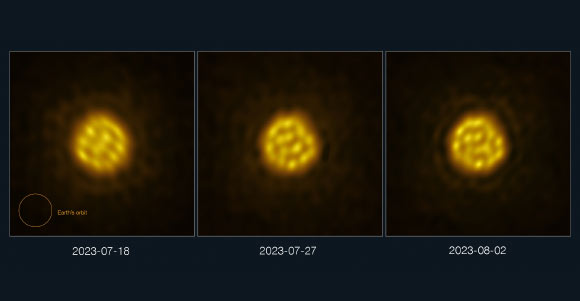
These giant, hot bubbles of gas on the surface of R Doradus are approximately 75 times the size of our Sun, according to a paper published in the journal Nature.

These images of R Doradus were taken with ALMA on July 18, July 27 and August 2, 2023. Image credit: ALMA / ESO / NAOJ / NRAO / Vlemmings et al.
R Doradus is located approximately 178 light-years away in the southern constellation of Dorado.
Also known as HD 29712, IRAS 04361-6210 or TIC 38877693, the star has a diameter of roughly 350 times that of the Sun.
Its mass is similar to that of our Sun, meaning R Doradus is likely fairly similar to how the Sun will look like in five billion years, once it becomes a red giant.
R Doradus is usually visible to the naked eye, but in the infrared light it is one of the brightest stars in the sky.
“Stars produce energy in their cores through nuclear fusion,” said Chalmers University of Technology’s Professor Wouter Vlemmings and colleagues.
“This energy can be carried out towards the star’s surface in huge, hot bubbles of gas, which then cool down and sink — like a lava lamp.”
“This mixing motion, known as convection, distributes the heavy elements formed in the core, such as carbon and nitrogen, throughout the star.”
“It is also thought to be responsible for the stellar winds that carry these elements out into the cosmos to build new stars and planets.”
“Convection motions had never been tracked in detail in stars other than the Sun, until now.”
Using the Atacama Large Millimeter/submillimeter Array (ALMA), the authors observed R Doradus over four weeks between July 2 and August 2, 2023.
They were able to obtain high-resolution images of the star’s surface.
“This is the first time the bubbling surface of a real star can be shown in such a way,” Professor Vlemmings said.
“We had never expected the data to be of such high quality that we could see so many details of the convection on the stellar surface.”
“Convection creates the beautiful granular structure seen on the surface of our Sun, but it is hard to see on other stars,” said Dr. Theo Khouri, also from the Chalmers University of Technology.
“With ALMA, we have now been able to not only directly see convective granules — with a size 75 times the size of our Sun — but also measure how fast they move for the first time.”
The granules of R Doradus appear to move on a one-month cycle, which is faster than astronomers expected based on how convection works in the Sun.
“We don’t yet know what is the reason for the difference. It seems that convection changes as a star gets older in ways that we don’t yet understand,” Professor Vlemmings said.
“Observations like those now made of R Doradus are helping us to understand how stars like the Sun behave, even when they grow as cool, big and bubbly as R Doradus is.”
“It is spectacular that we can now directly image the details on the surface of stars so far away, and observe physics that until now was mostly only observable in our Sun,” said Behzad Bojnodi Arbab, a Ph.D. student at the Chalmers University of Technology.
_____
W. Vlemmings et al. 2024. One month convection timescale on the surface of a giant evolved star. Nature 633, 323-326; doi: 10.1038/s41586-024-07836-9
 Print
Print


